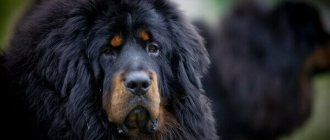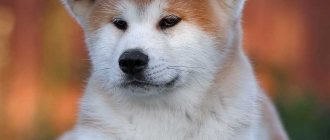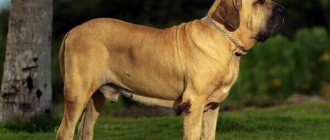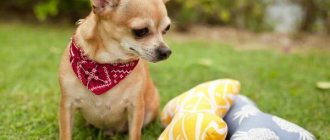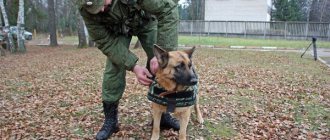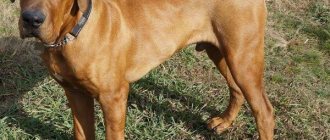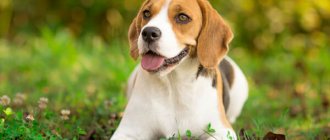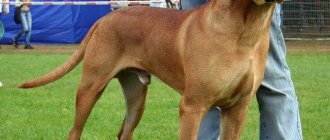Mastiffs are a common name for a group of breeds that include Neapolitan, Major, South African, English, Spanish, Brazilian, American and other varieties of similar dogs.
The Tibetan Mastiff is the oldest breed of dog in the world, most of whose activity was limited to maintaining order in Tibetan monasteries.
In addition, the dog did not disdain helping nomads in the Himalayan mountains.
The entire history of the formation of the breed is replete with legends and myths; moreover, many authors sincerely sang the strength of these dogs, be it physical or spiritual.
History of the Tibetan Mastiff breed
Tibetan Mastiff
The history of the origin of Tibetan mastiffs is shrouded in a trail of mystery, since the first dogs appeared long before the emergence of writing in certain regions of Tibet. The approximate age of the breed could only be determined through genetic research, initiated by employees of the Chinese University of Molecular Evolution. By comparing the mitochondrial DNA of a wolf and a dog, scientists found that the first signs of their differences from each other appeared about 42 thousand years ago. A similar experiment with mastiff DNA showed a different result - 58 thousand years. This allows us to consider the breed one of the oldest in the world.
Archaeological finds - animal bones and skulls - suggest that the ancestors of mastiffs walked side by side with people back in the Stone and Bronze Ages. As for mentions of the breed in written sources, they date back to the first half of the 12th century. In 1121, the Emperor of China received a luxurious gift - huge hunting dogs that looked like mastiffs.
Tibet is considered the birthplace of the breed - a sacred place for followers of Buddha and his teachings. Thanks to their physical and intellectual strength, dogs became indispensable companions in those harsh living conditions. The animals often demonstrated ferocity, which is why many owners kept the mastiffs locked up, only letting them out to stretch their paws at night: mountain villages always needed increased protection.
Mastiffs were also widely used to protect the peaceful tranquility of monasteries. Then the animals worked in the company of Tibetan spaniels. The latter started barking uncontrollably when strangers invaded and thereby called on mastiffs for help - heavier “artillery”. Considering the fact that these large dogs fearlessly entered into battle even with snow leopards, monks and novices did not have to fear armed raids and invasions.
It was the geographical remoteness of Tibet that became the reason why the breed managed to retain its original features for thousands of years. Only occasionally did mastiffs “migrate” to other countries - mainly as trophies or valuable gifts. According to historical data, similar dogs accompanied Genghis Khan's army in battles, and the rest of the time they performed guard duty. The distant ancestors of mastiffs were also found in other armies of the ancient world, who fought with the Romans, Greeks, Assyrians and Persians.
At the turn of the 13th-14th centuries, Marco Polo, an Italian traveler and merchant, set foot on the lands of Tibet. In his writings, he mentions the mastiff - a huge and angry dog, which was almost larger in size than a pack donkey. Her voice was loud and booming, like the roar of a lion, and her eyes became bloodshot at the slightest hint of danger. Although, perhaps, the merchant only recorded the observations of other travelers, who could have embellished the reality. By the way, many dog handlers adhere to precisely this point of view, although they admit that such a colorful description excites the imagination of impressionable people.
Tibetan mastiff puppy
For a long time, the whole world was content with only fragmentary stories from travelers about the powerful and majestic dogs of Tibet. The spread of the breed throughout Europe began in 1847, when the future Viceroy of India, Lord Harding, presented Queen Victoria with an unusual gift - a Tibetan mastiff, which was later named Siring. In the second half of the 19th century, Edward VII returned to his homeland along with two representatives of the breed. They were later shown at an exhibition at the London cultural and entertainment center Alexandra Palace.
These were the first glimpses of the West's timid acquaintance with the Tibetan mastiffs, which for several millennia were completely isolated from the outside world. This amazing breed began to gain popularity among aristocrats, and mastiffs increasingly began to be imported into Great Britain, from where they later spread throughout Europe. This process took the next fifty years.
In 1931, interest in mastiffs resulted in the creation of the Tibetan Dog Breeds Association. At the same time, the first breed standard was formulated. Its author was the wife of Lieutenant Colonel Frederick Bailey, who acquired four Tibetan mastiffs and returned with them to England. This standard was later taken as a basis by such cynological organizations as FCI and Kennel Club.
The outbreak of World War II almost put an end to the spread of the breed around the globe. The flow of mastiffs, which were brought from Nepal and Tibet, temporarily stopped, and breeders had to make enormous efforts to preserve the breed. It has not yet been established how the dogs ended up in the United States in 1950 as a gift to then-President Eisenhower. However, this gesture of goodwill was not received with enthusiasm, and the breed itself did not win the love of the Americans. Gradually the mastiffs were sent to the ranch and forgotten for twenty years.
Since 1969, dogs were again brought to the United States - this time straight from their historical homeland. Five years later, on the initiative of dog handlers, the American Tibetan Mastiff Line Association (ATMA) was created. It also became the main club for breed lovers. In 1979, mastiffs bred in the USA took part in the exhibition for the first time and gained dizzying success.
Today the Tibetan Mastiff is one of the rare dog breeds. Thus, about three hundred purebred specimens live in the UK. As for the United States, mastiffs are ranked 124th out of 167 existing breeds. In Russia, these dogs continue to gain popularity, but it is still not enough to open full-fledged nurseries.
Owner reviews
Real positive and negative reviews from the owners of these dogs will help you decide whether to get such a pet.
I can say they are adorable! There is such a lion running around our yard, there’s no other way to call it. I would like to especially note in my review the relationship with children. If I let the children go for a walk in the yard, then I don’t even worry about them, since our Baron will not allow them to go outside the gate or do mischief. He is very helpful with children and loves to play with them. I love looking at him when he’s not contentedly puffing his cheeks, it makes me feel tender. Of course, you need to tinker with the fur quite a bit, but thanks to the character qualities of this dog, I do such procedures with joy.
It took us about three years to choose the breed of dog that we would get to guard our house, which was still under construction. It’s a pity that nurseries are located only in the center of Russia, while we live better in Siberia. But this did not become a problem for us. The dog is very smart, stubborn, and calm in nature. Of course, I will especially emphasize in the review that it is not suitable for living in an apartment, but thanks to this we completed the construction of our house much faster. Masyanya became a teacher for our children, she is very patient with them, but does not let them go too far and puts them in their place on time. I think that this is the most suitable option for those who want to protect their home and family, of course, if they can afford the expensive maintenance of such a dog.
Our clumsy Barik immediately made friends with the cat, who was not very happy about the appearance of a puppy in the house. But after some time they became best friends. The dog will also never offend the neighbor's cats, which sometimes come into our yard. And with children he is absolutely golden, a real helper. I recommend this breed to everyone.
But our mastiff is two years old. And I can say that the dog is very difficult. In China there is a name for this breed. There is a dog, and there is a Tibetan mastiff. Our pet constantly tests us, he always wants to prove that he is the boss in the house. He is a miracle! We love him very much! But he is so smart and cunning that sometimes it becomes scary!
Think before you buy such a dog! They write that they are wary of strangers and are adequate in your presence. Nonsense, don't believe it! at 4 months he bit a builder on the property, he will tear anyone, I’m not kidding - he WILL TEAR. If we are talking about a dog for a family, then this is not the breed, if we are talking about guarding an object - of course yes.
Appearance of the Tibetan Mastiff
Muzzle of a Tibetan Mastiff
The Tibetan Mastiff is a large breed of dog. This is a strong animal with heavy and durable bones. Despite its impressive size, the mastiff looks proportional.
The FCI standard suggests that the minimum height for males is 66cm, while females typically grow to 61cm and above. As for body weight, ideally it reaches 64-78 kg.
Head and skull
The head of the Tibetan Mastiff is commensurate with its dimensions: it is very heavy and strong - in general, ideally matching the appearance of the dog. The rounded skull has a pronounced bump on the back of the head.
Muzzle
The Mastiff has a very wide muzzle, which looks square from the front. The transition to it from the forehead is well defined. A wide nose with large nostrils is distinguished by black pigmentation or as close as possible to it. The fleshy lips are adjacent to the lower jaw. In adult Tibetan Mastiffs, a fold on the side of the muzzle is acceptable.
Ears
Triangular ears are set above the eyes, but not reaching the line of the skull. The Mastiff's ears are drooping and droop slightly forward, but can be raised if the dog is restless.
Eyes
The oval eyes are set slightly obliquely and widely apart. They have a brown tint, and the richer it is, the better. The eyelids fit tightly.
Jaws and teeth
The jaws of the Tibetan Mastiff are quite strong. The dog's upper incisors overlap the lower ones, thereby forming a scissor bite (straight bite is also allowed). The teeth “sit” vertically and tightly in relation to each other.
Neck
The dog's muscular and strong neck has a pronounced scruff and a slight dewlap. The thick fur forms a mane. It is worth noting that it is less noticeable in females than in males.
Fluffy watchman
Frame
Adult Tibetan Mastiff next to a man
The Tibetan Mastiff has a strong body. The muscular back extends into a wide croup. The “heart” shape that the chest has is quite remarkable. It is formed by the slightly rounded ribs of the dog. The lower part of the chest is below the level of the elbows.
Tail
The tail is of medium length and set quite high. It is casually thrown on the back and raised during the movement of the mastiff or at the moment when the dog is alarmed by something. Covered with long and close-lying hair.
Forelegs
They have strong bones and pronounced articulation angles. The Mastiff's muscular shoulders are well sloping and flow into straight forearms. Elbows point straight back. The breed standard does not allow them to turn outward or inward. The pasterns are set at a slight angle. The forelimbs end in large and strong paws with curved toes.
Hind limbs
Parallel to each other, which is noticeable when examining the Tibetan Mastiff from behind. The long thighs are quite muscular. The dog's knees are well defined. Dewclaws are often removed at the request of the mastiff owner. The pigmentation of the paw pads is predominantly black or matches the color of the animal.
Movement style
The movements of the Tibetan Mastiff combine strength and lightness; They are distinguished by a confident push and extension of the limbs. When walking at an accelerated pace, the dog moves its legs to a conventional line in the center. In other cases, the animal moves slowly, demonstrating nobility.
Coat
Tibetan Mastiff puppy at an exhibition
Under the hard and straight coat lies a thick undercoat, which sheds during the warm season. A mane forms on the dog’s neck, which gently falls onto the shoulders. Feathering is visible on the dorsal surface of the hind legs.
Color
The breed standard calls for shades that are as pure as possible (regardless of the base color). Tan varies between light and rich chestnut. Moreover, it is located mainly above the dog’s eyes, on the lower part of the limbs and tail. The presence of “glasses” is acceptable. The same applies to the white spot on the chest, but on the paws this color should not be intense. The main colors of the mastiff include sable, golden (shades of any saturation are possible), blue (with or without points), black and tan and black.
Possible defects
The slightest deviations from the standard are considered defects. Among them the most common:
- smoothed or defined angles of the limbs;
- large or very low-set ears;
- rounded ribs (like a barrel);
- light color of the iris of the eyes and nose;
- loose lips;
- brightly defined dewlap;
- stiffness of movements;
- curled tail.
Disqualifying defects include:
- color different from that accepted by the standard;
- cowardly or aggressive behavior;
- overshot or undershot jaws;
- undescended testicles.
Peculiarities
In general, these dogs have fairly good health, although there are some peculiarities in the breed:
- Due to their large size and heavy weight, they may be prone to hip disease - dysplasia .
- There is also a tendency to thyroid diseases . These diseases can be inherited.
- There is a danger of genetic problems that can appear at the age of 7-10 months and lead to the death of the puppy. In nurseries, when choosing a pair, they strictly monitor the compatibility of the pairs.
- There may also be health problems, particularly with the skeletal system , which are common in large dogs. This may be inflammation of the pericartilaginous tissue, rickets, hypertrophy or dystrophy of bones in puppies. A proper diet containing enough calcium and other substances necessary for the development of the puppy will help to avoid the development of these diseases. Daily physical activity is also necessary.
- There is still a risk of skin diseases . These dogs have very thick fur, and skin diseases can occur due to heat, or if the coat is not well dried after bathing, or due to poor diet.
- To avoid the risk of infections and viruses, it is necessary to get vaccinated on time.
Photo of Tibetan Mastiff
Video
Watch educational videos about the breed:
Thus, the Tibetan Mastiff is distinguished as a guard and a loyal friend, despite its impressive size, its maintenance is not too difficult. This pet is suitable for experienced dog owners; it gets along well with children and other animals, but has an independent and stubborn disposition. If you are the happy owner of this Tibetan treasure, you can share your experience, give advice to those who are planning to get one, and show a photo of your dog.
From our article you learned the characteristics, reviews and cost (exact price in Russia) of the dog breed, photos, weight, height, feeding and care.
Character of the Tibetan Mastiff
Self-confident, balanced and independent - these are the epithets that come to mind when meeting a Tibetan mastiff for the first time. A dog has an indestructible sense of self-esteem and requires an appropriate attitude towards itself: not as a pet, but as an equal being. The Mastiff is not prone to show nervousness, cowardice or unreasonable aggression, like representatives of small breeds. This is a discreet and independent animal that behaves with royal dignity and never barks over trifles.
Tibetan Mastiff with owner
The thousand-year history of the breed and the original purpose of its representatives explain the fact that mastiffs have excellent instincts when it comes to protecting the territory entrusted to them. For the same reason, dogs tend to be nocturnal, because their distant ancestors gained energy and strength during daytime sleep in order to begin work at nightfall. So don't be surprised if your Tibetan suddenly becomes restless and noisy when you go to bed. In rare moments, a dog may bark, seeing a potential danger in a quiet rustle or creaking. Consider this fact if you have overly irritable neighbors who will not miss the chance to express their indignation.
The animal's attitude towards strangers is mostly reserved - especially in the presence of the owner. The mastiff will never rush to attack first in the absence of a threat, but rest assured: not a single movement of an uninvited guest will escape his gaze. Representatives of this breed have well-developed intuition, so a dog can put up with the company of not every person. And this is an excellent reason to think, are you really communicating with a friendly and pleasant company?
Speaking of friends... If you are a fairly sociable person and regularly invite guests for tea, the mastiff will not fully come to terms with this fact and will make any attempts to limit the number of people in your house. Families with children should also pay attention to this fact. Excessively active and loud games of a child with his friends can be perceived by a Tibetan as a threat and a manifestation of aggression. The mastiff, without hesitation, will come to the defense of its little owner, and taking into account the dog’s powerful dimensions and impressive body weight, this can end in very disastrous circumstances.
Tibetan mastiff with a child
Representatives of this breed are dominant towards other pets. The exception is the pets with whom the Tibetan grew up: in this case, the dog considers them members of its pack. This applies equally to cats and other dog breeds. However, it is not recommended to get new animals if an adult mastiff already lives in your home. In this case, rivalry cannot be avoided.
When around family, Tibetans are friendly and love to spend time with their owner, so get ready to have a miniature version of Chewbacca from Star Wars lying at your feet every day and snoring peacefully in response to the dog's dreams. Adult mastiffs are calm, but puppies are full of strength and energy. If not properly trained, these plump cubs will turn your home into ruins in a matter of minutes, so do not leave them unattended for a long time.
Beware if your pet gets bored! Tibetan Mastiffs tend to chew on everything that is within their sight. If you value your furniture, make sure you have enough toys and don't forget to walk your dog in the city park. Tibetans will run after a frisbee with puppy delight, and after the game they will happily lie down in the shade of spreading trees. A winter walk is especially appreciated by representatives of this breed: when else will there be a chance to tumble in the snow, which is so reminiscent of the historical homeland of mastiffs - Tibet?
Tibetan Mastiff puppy with mom
Price
There are quite a lot of mastiff nurseries in Russia; they are in Moscow and St. Petersburg. The cost of a powerful guard dog is not small. The buyer must decide in advance whether he needs a pedigree for the dog; if so, then he will have to set aside at least another 10 thousand rubles.
So, the price of a Tibetan mastiff with documents is from 50 to 65 thousand rubles. This is what breeders demand for puppies with impeccable health. Private owners sell such pets more than 2 times cheaper, from 10 to 25 thousand rubles.
Education and training
Due to its independent and somewhat stubborn nature, the Tibetan Mastiff is difficult to train (especially if it does not recognize the dominance of its owner). Tact and patience are your main weapons in the process of raising an animal and teaching it new commands. Avoid rude words and actions, otherwise the puppy will grow into a real problem, which will not be so easy to deal with.
The Tibetan mastiff lay down to rest and took over the entire bench
It can take about two years to fully train a Tibetan Mastiff. If you do not have enough time and experience, it is best to turn to specialists who will not only teach your dog basic commands, but also share effective tips for raising this furry giant.
An important aspect is imprinting - a set of techniques aimed at teaching an animal to unquestioningly trust its owner. Don't forget to pet the puppy and show affection. You may even have to sacrifice your own clothes for this: the mastiff loves to “chew” a person, thereby expressing his affection and desire to start another fun game. If this does not happen, and the laces on your sneakers are still intact, think about it: the puppy simply does not trust you and will not become a devoted friend in the future.
Early and proper socialization is very important for representatives of this breed. Already from the seventh week, the mastiff should be among people and other animals and thereby get used to the fact that the whole world does not revolve around his person. For the same purpose, it is recommended to invite guests to your home so that the dog gradually gets used to strangers on its territory and does not show aggression towards strangers.
When walking, you should not stick to one route. Firstly, your pet will quickly get bored and will soon stop enjoying the walk. Secondly, a change of place will allow the mastiff to understand that he does not own the whole world, and thereby make the animal more tolerant of other creatures.
Tibetan Mastiff at home
Where is it better to keep it, in an apartment or on the street?
On this issue, the opinions of breeders and dog handlers are divided . Some believe that a mastiff does not belong in an apartment, others do not agree with this.
In practice, there were cases when keeping a Tibet in an enclosure did not give him the proper stress, because the owners were sure that they could limit themselves to walking.
In an apartment, the animal is often allocated a part of the living space, where the dog spends most of its time . But if the owner does not pay enough attention to the animal, then Tibet will fall into depression.
The situation is similar with a private house. A mastiff should not be left unattended in the yard, as the dog needs communication. In the worst case, the animal will begin to look for company on the side or acquire the habit of digging.
IMPORTANT!
If the owner has a yard, then it is worth making sure that it is well fenced.
Dogs are rarely limited to one territory, and some even strive to climb through the fence and escape.
Care and maintenance
Huge size and long hair - this is why caring for a Tibetan mastiff takes so much effort and time. The dog’s thick coat, which has a dense undercoat, deserves special attention. Despite the fact that representatives of the breed rarely develop tangles, regular brushing is still necessary. It is carried out no more than three times a week, using a metal brush. Before combing, it is recommended to spray the hair with diluted conditioner or water: this will make the procedure a little easier.
Don't forget to take care of your Tibetan Mastiff's coat!
If you do find tangles - they mainly appear on the animal’s ears, neck and hind legs - use a tangle cutter and a special spray to gently remove them. Please note that Tibetan mastiffs shed heavily in spring and autumn, so additional devices can be used - a furminator or a slicker.
It is strictly forbidden to shorten a dog's fur using a hair clipper! This is fraught with impaired thermoregulation and, consequently, frequent pneumonia.
The Mastiff is not a breed that needs regular bathing. To maintain cleanliness, it is enough to give the animal a bath day once every three months. In addition, frequent water procedures hypertrophy the dog’s skin glands, which is fraught with the appearance of a specific and well-known “dog” smell. An excellent alternative to bathing is dry shampoo, which is rubbed into the Tibetan Mastiff's coat and then combed out thoroughly.
To shorten nails, use a nail clipper for large dog breeds, and to smooth out sharp edges, use a nail file. Soak your pet's paws in warm water first to make the procedure easier. It is repeated once a month. In this case, the hair between the toes of the Tibetan mastiff is carefully trimmed, and the paw pads are lubricated with oil. This will avoid the formation of cracks, which cause significant discomfort to the dog.
You should brush your pet's teeth twice a week. Use a brush or a special attachment on your finger and under no circumstances “share” your toothpaste with the Tibetan: there is a special one for dogs for this. In addition to plaque, tartar can also form in your pet’s mouth, so you need to take care of the presence of special toys and solid food in the dog’s diet. Thanks to them, the mastiff's teeth will retain their strength for a long time.
What are you watching? Pass by
The ears of a Tibetan also need your attention. To keep them clean, wipe your ears once a week with a damp cloth. In winter, do not go for a walk with your animal until its ears are completely dry. The same goes for the eyes. When doing this, use a soft, lint-free cloth moistened with chamomile infusion.
The health of the Tibetan Mastiff is largely determined by a balanced diet. In the first months of a dog’s life, it is necessary to take care of a sufficient amount of calcium: the joints of such a massive giant are subject to heavy load every minute. Otherwise, the optimal way to feed a Tibetan is premium dry food or natural food. Please note that combining the two types of food can cause problems with your dog's digestive system.
Do not include the following foods in your Tibetan Mastiff's diet:
- river fish (in any form);
- spicy and salty foods;
- tubular bones;
- flour products;
- fat meat;
- smoked meats;
- raw eggs;
- potato;
- sweets;
- nuts.
Natural food is always served fresh and not hot. The same goes for drinking water.
Diet
The diet of the Tibetan Mastiff can be divided into two types: natural food and combined dry food.
Natural food type
Natural nutrition should be balanced, include all the necessary substances for building the body, normal metabolism, and obtaining energy. Proteins, fats, carbohydrates, microelements and macroelements, water - all these substances must enter the body in the required quantities. And you need to ensure that in addition to these substances, various toxins, bacterial and viral pathogens, or even parasites are not introduced.
From two months of age, the Tibetan Mastiff needs to be fed six times a day using the following foods:
- Dietary meat, an example of which is beef.
- Kefir.
- Cottage cheese.
- Various cereals, the best choice is buckwheat or rice.
- Eggs.
- Vegetables (boiled).
- Fruits (fresh).
- Olive oil.
- Green herbs - parsley or dill.
A veterinarian will help you choose the right diet for your dog, and he will also help you choose a special vitamin supplement.
By the sixth month of life, feeding a Tibetan should be switched to five meals a day. In addition to the above products, you can add boneless fish. An adult dog is fed two to three times a day.
The amount of food per day must be calculated based on the dog’s weight. A mastiff should eat exactly three percent of its own weight per day.
Rare gray color of the Tibetan Mastiff
Dry food
Dry ready-made food is also an excellent solution. It is balanced in micro and macroelements; no special vitamin supplement is required. A wide range from which you can choose the ideal option for each individual based on the age, gender, physiological state and financial situation of the owner.
What should you pay attention to?
- Color. High-quality food is dark brown in color and does not contain dyes or flavor enhancers.
- Meat. A high-quality food should contain at least 50% meat, since a dog is still a predator, and this type of nutrition is provided for by evolution. As a rule, this is beef or turkey, but chicken or fish are found in cheap feeds.
- Vegetables. They are considered in the composition together with cereals. A good food should contain less than 50%.
- By-products Conscientious producers indicate which by-products are used in the production of feed. The food may contain lungs, kidneys and liver. Otherwise, hooves and skins can be used.
- Dyes
Food is divided into several types - economy, elite and premium, but this does not mean that economy-class food is necessarily bad. It’s just that their energy value is much lower.
When feeding dry concentrated food, the dog must have free access to water.
Vitamins and supplements
Due to the genetic predisposition of Tibetan mastiffs to joint diseases, it is necessary to add so-called chondroprotectors to their food - supplements aimed at protecting the cartilage formations of the body. Mixtures with calcium and phosphorus are often used.
Tibetan Mastiff Health and Diseases
Running Tibetan Mastiff puppies
People from snowy Tibet enjoy excellent health. So, adult mastiffs practically do not get sick. However, there are diseases that are typical for all representatives of this breed:
- decreased thyroid function or disease;
- dysplasia of the elbow or hip joints;
- hypertrophic neuropathy;
- inflammation of the tubular bones;
- ear infections;
- osteochondrosis.
Visit the veterinarian on time and do not forget that a vaccinated pet is a healthy pet.
Maximum parameters
The largest Tibetan mastiff is rightfully a dog named [ link_webnavoz]Hong Dong[/link_webnavoz] , that is, Big Splash .
The weight of this dog is almost twice the norm. When the dog was eleven months old, his weight had already reached 130 kg. The Mastiff continues to grow and its final weight and height will be established by the age of three.
Hong Dong became a record holder for the price paid for it. The giant Tibetan mastiff cost its new owner $1.5 million .
However, in the ranking of the largest dogs in the world, Hong Dong ranks only sixth.
The high price for which the mastiff was given is due to the color of the coat . The dog's color is red, which is considered lucky among the Chinese. Already, applications are being submitted to the new owner to mate with Hong Dong.
For the opportunity to have offspring from such a large mastiff, dog owners are willing to pay 15 thousand dollars.
How to choose a puppy
It is best to buy a Tibetan Mastiff from nurseries that breed this breed. If pedigree is important to you, ask the breeder to provide all the information and photographs of adults who will later produce offspring. At the same time, you can book a puppy from a specific mastiff pair or take the baby you like four weeks after its birth.
Puppies should be kept in a spacious and carefully cleaned environment and should be playful and have a healthy curiosity. Carefully examine the baby's skin and mucous membranes. The eyes and nose should be clean and free of painful-looking discharge. Ideally, pustules and other types of irritation are also absent. A small Tibetan should be moderately heavy and well-fed, with a wide muzzle and thick feet. The thicker the coat, the better. Please note that the puppy should not be cowardly or aggressive.
Listen to your heart - and it will not deceive you!
Standard sizes
The strongest dog in the world in terms of fighting: top 10
Mastiff is a large dog, height at the withers is from 66 cm (males) and from 61 cm (females). Male weight is 45-74 kg, female – 35-55 kg. The maximum weight of representatives of the breed is 115-130 kg, while the dogs are not fat; their impressive muscle mass gives them impressive weight.
Note! If you plan to participate in exhibitions, you need to watch your diet. The dog has a predisposition to rapid weight gain.
Reliable security guard
